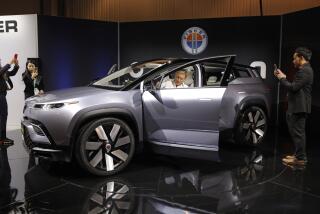India’s Tata Motors unveils the world’s cheapest car
- Share via
NEW DELHI — With the flash of cameras and oohs and aahs from the crowd, an Indian company Monday launched what is billed as the world’s least expensive car, six years after it was conceived and six months behind schedule.
The Nano will start at $2,200 after taxes and dealer costs, while the more expensive CX and LX models with heat, air conditioning and power brakes will go for as much as $3,800.
None of the models, made by India’s giant Tata conglomerate, have air bags or anti-lock brakes. But they will meet or exceed all Indian safety standards, company officials said.
“I hope it will provide safe, affordable four-wheel transportation to families who until now have not been able to own a car,” Ratan Tata, company chairman, told reporters.
Amid the applause and homegrown pride at India’s accomplishments, however, some here expressed concern about the environmental impact of a “people’s car” so inexpensive that it will be within reach of millions more people, further clogging the roads and polluting the air.
“At this time, when India is just beginning to motorize, it’s absolutely essential that we grow differently and not become as car-centric as the rest of the world,” said Anumita Roychowdhury, associate director of the Center for Science and Environment in New Delhi. “It’s a natural aspiration that people want to own a car, but it’s important to offer public transportation options.”
The initial focus will be on the Indian market and its rising middle class, but the company plans to roll out a more expensive European version in 2011 with air bags and better emissions and safety ratings. It may also consider a model for the U.S. market.
China’s Cherry QQ car sells for about $4,800 and India’s Suzuki Maruti 800 for about $5,000. The least expensive U.S. car is the basic Chevrolet Aveo, with a nearly $12,000 base price. Nissan offers its subcompact Versa model in the U.S. at a base price of $9,999.
Tata Motors, which last year bought Jaguar and Land Rover, has seen its debt soar in recent months, as have carmakers around the world. To help ease its cash squeeze -- the company suffered its first loss in seven years last quarter -- it is taking sizable advance deposits.
Protests by farmers and a politician’s hunger strike last fall forced the company to shutter its main Nano factory in West Bengal state, delaying the launch by half a year. Since then, the global economy has deteriorated significantly.
Tata said it would hold a lottery starting April 9 for the 1 million applicants vying for the 60,000 or so vehicles expected to be produced in the first year. Those who are selected will be asked to put up a deposit of as much as 80% of the price. Delivery is to start in July.
The four-door vehicle, similar in look and size to Mercedes’ Smart Car, has the smallest footprint and turning radius of any car in India, the company said. At 10 feet long and less than 5 feet wide, it has a single windshield wiper and gets about 47 miles to the gallon from a two-cylinder engine that is hardly bigger than an outboard motor. With its limited power and top speed of about 65 mph, analysts said, it will be largely limited to city driving.
“The Nano is good for customers, good for business, good for the industry,” said Murad Ali Baig, an independent auto analyst based in New Delhi. “In the early years, a car in India was considered a rich man’s toy. Now it’s seen as part of life.”
Some of the demand is expected to come from motorcycle owners switching to four wheels -- it’s not unusual to see a whole family on one bike here -- and other sedan owners. Competing automakers are watching closely, ready to jump in with their own low-priced model if the Nano succeeds.
India’s car industry has ample room to grow by the standards of other nations, with just 14 cars per 1,000 population, according to industry figures. That compares with 28 per 1,000 for neighboring Sri Lanka, 400 to 600 per 1,000 for Europe and Japan, and more than 700 per 1,000 for the U.S.
Utsav Chibbad, 27, a retail worker out shopping at a Suzuki-Maruti dealership on New Delhi’s Africa Avenue, said he dreads the prospect of thousands of new Nanos clogging India’s already jammed roads.
“What a nuisance,” he said. The environment? He’s not particularly worried. “Things are already so haywire, what difference will it make,” he said.
That sort of attitude concerns Indian environmentalists worried about the planet, quality of life and the cycle of materialism that results with aping Western lifestyles.
“They say everyone having a car is development,” said Vinay Jaju, an activist working to spread awareness about solar vehicles. “I don’t see it that way. We need to save our resources, otherwise it all becomes a vicious cycle.”
If the real estate sweeteners, tax breaks, interest-free capital and other subsidies Tata got are factored in, Roychowdhury said, the Nano would probably cost 60% more. And that doesn’t count parking and infrastructure subsidies car owners in India enjoy.
Public buses in India, which carry 50% of the traveling public while using just 5% of the road capacity, are hit with much higher taxes. And when auto giants around the world go bust, Roychowdhury added, they are bailed out by taxpayers to the tune of billions, “fanning more greed and greater car dependency.”
Those concerns aren’t putting a damper on the Nano’s coming-out party.
“It’s Nano-mania,” said Baig, the analyst. “With India’s hot and horrible climate, it’s about time people have an alternative to those terrible buses.”
--
Pavitra Ramaswamy of The Times’ New Delhi Bureau contributed to this report.






